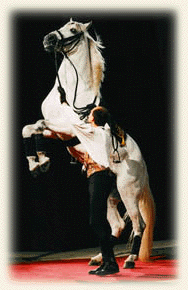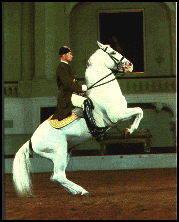
![]() In the year
1580, Archduke Charles II established a horse breeding farm in Lipizza
(Lipica). He selectively bred the most superior specimens from the Spanish
horses, Barbs, Andalusians, Berbers and Karst - the local breed. This
selective breeding produced the ancestors of today's Lipizzan breed.
In the year
1580, Archduke Charles II established a horse breeding farm in Lipizza
(Lipica). He selectively bred the most superior specimens from the Spanish
horses, Barbs, Andalusians, Berbers and Karst - the local breed. This
selective breeding produced the ancestors of today's Lipizzan breed.
![]() Well reknowned
for their high-stepping gait, the Lipizzan also possesses a combination
of courage, strength, ability, temperament and intelligence, all wrapped
up in a beautiful, noble package. The Lipizzan line was owned exclusively
by the Habsburg monarchy, until the year 1916. During wartimes, the horses
were moved to various locations for safety -- at the same time as the
Napoleonic Wars, Napoleon gained possession of the Lipizzans for a short
time and introduced the Arab into their breeding.
Well reknowned
for their high-stepping gait, the Lipizzan also possesses a combination
of courage, strength, ability, temperament and intelligence, all wrapped
up in a beautiful, noble package. The Lipizzan line was owned exclusively
by the Habsburg monarchy, until the year 1916. During wartimes, the horses
were moved to various locations for safety -- at the same time as the
Napoleonic Wars, Napoleon gained possession of the Lipizzans for a short
time and introduced the Arab into their breeding.
![]() The breeding
stock was moved to Laxenburg (near Vienna) during World War I. After the
War, while central Europe reorganized, the large Austrian-Hungarian empire
divided into several smaller republics -- each inheriting some of the
royal breeding stock of Lipizzans. Of the known 208 Lipizzans in existance,
109 were sent to Italy -- where the village of Lipizza and its surroundings
had been awarded. Some of the foals remained in Kladrub, a then Czechoslovakian
owned state, while the remaining breeding stock and the stallions of the
Spanish Riding School was left to the republic of Austria.
The breeding
stock was moved to Laxenburg (near Vienna) during World War I. After the
War, while central Europe reorganized, the large Austrian-Hungarian empire
divided into several smaller republics -- each inheriting some of the
royal breeding stock of Lipizzans. Of the known 208 Lipizzans in existance,
109 were sent to Italy -- where the village of Lipizza and its surroundings
had been awarded. Some of the foals remained in Kladrub, a then Czechoslovakian
owned state, while the remaining breeding stock and the stallions of the
Spanish Riding School was left to the republic of Austria.

![]() The
Lipizzan breed was again threatened by extinction in 1943, when the mares
and foals from Austria, Italy, and Yugoslavia were transferred to Hostau
in Czechoslovakia by the German High Command. The then director of the
Spanich Riding School saved the performance stallions - yet the horses
were not returned to the school. In 1945, the American army, under the
command of General Patton, guaranteed the survival of the breed when they
retrieved the mares and returned them to Austrian soil.
The
Lipizzan breed was again threatened by extinction in 1943, when the mares
and foals from Austria, Italy, and Yugoslavia were transferred to Hostau
in Czechoslovakia by the German High Command. The then director of the
Spanich Riding School saved the performance stallions - yet the horses
were not returned to the school. In 1945, the American army, under the
command of General Patton, guaranteed the survival of the breed when they
retrieved the mares and returned them to Austrian soil.

![]() The
Lipizzan today, is used for competition dressage and driving, as well
as the ultimate mount for classical horsemanship and pleasure riding.
Lipizzans and Lipizzan-Arab crosses were used for the chariot races in
the movie Ben Hur. Another Lipizzan stallion was used in a 1976 Paul Newman
movie, as Buffalo Bill's horse. Some Lipizzans are used in circuses. Before
1981, Lipizzans were difficult to acquire. Today, Disneyland owns a number
of Lipizzan mares; the Marine Corps uses them in their Color Guard; and,
even former President Reagan has one in San Simeon, California.
The
Lipizzan today, is used for competition dressage and driving, as well
as the ultimate mount for classical horsemanship and pleasure riding.
Lipizzans and Lipizzan-Arab crosses were used for the chariot races in
the movie Ben Hur. Another Lipizzan stallion was used in a 1976 Paul Newman
movie, as Buffalo Bill's horse. Some Lipizzans are used in circuses. Before
1981, Lipizzans were difficult to acquire. Today, Disneyland owns a number
of Lipizzan mares; the Marine Corps uses them in their Color Guard; and,
even former President Reagan has one in San Simeon, California.
![]() Lipizzans
are not very tall, the largest stands about 16 hands. They are late maturing,
and long lived - often to 35 or more years of age. From birth, they display
elegance and nobility; born black or bay, they slowly turn "white" by
the time they are five to eight years of age. They are not fully grown
in size until they are seven and do not reach full maturity until almost
ten years of age -- as a yearling, they look shockingly small compared
to a Thoroughbred of the same age. But their proud carriage, muscular
bodies and elastic, powerful movements make them appear much larger than
they really are.
Lipizzans
are not very tall, the largest stands about 16 hands. They are late maturing,
and long lived - often to 35 or more years of age. From birth, they display
elegance and nobility; born black or bay, they slowly turn "white" by
the time they are five to eight years of age. They are not fully grown
in size until they are seven and do not reach full maturity until almost
ten years of age -- as a yearling, they look shockingly small compared
to a Thoroughbred of the same age. But their proud carriage, muscular
bodies and elastic, powerful movements make them appear much larger than
they really are.
![]() Around
eight months of age, Lipizzans go through an awkward "ugly duckling"
stage, that lasts until they are 3-years-old, when the elegance they are
known for and had from birth, finally returns and remains until they die.
Around
eight months of age, Lipizzans go through an awkward "ugly duckling"
stage, that lasts until they are 3-years-old, when the elegance they are
known for and had from birth, finally returns and remains until they die.

![]() Lipizzans
are usually sound, with heavy bones - lameness is rare - and a joy to
ride, partially from their broad backs and lively gait. They have a natural
sense of rhythm and carry themselves with a natural balance; they are
extremely quiet and steady under saddle. The stallions are docile and
easy to handle - more so than mares, as they tend to be a little bossy
in a motherly way.
Lipizzans
are usually sound, with heavy bones - lameness is rare - and a joy to
ride, partially from their broad backs and lively gait. They have a natural
sense of rhythm and carry themselves with a natural balance; they are
extremely quiet and steady under saddle. The stallions are docile and
easy to handle - more so than mares, as they tend to be a little bossy
in a motherly way.
![]() For more
information on this beautiful breed, contact :
For more
information on this beautiful breed, contact :
The
Lipizzan Billboard
Lipizzan Association
of North America
